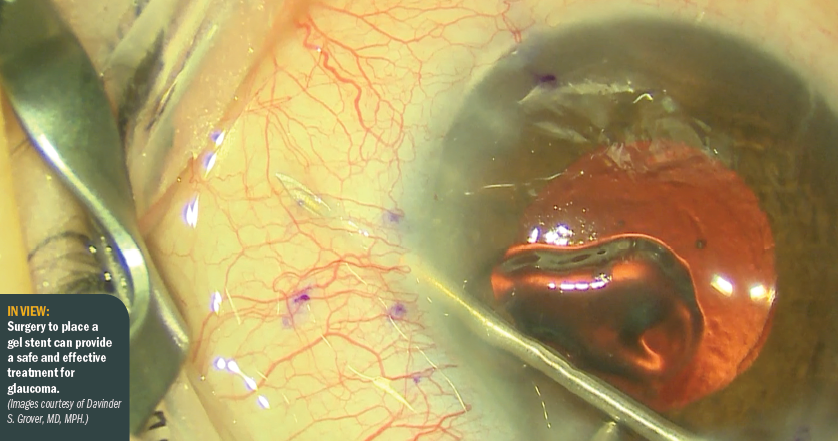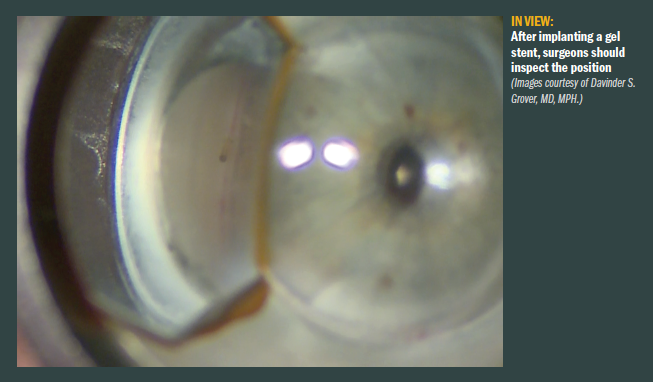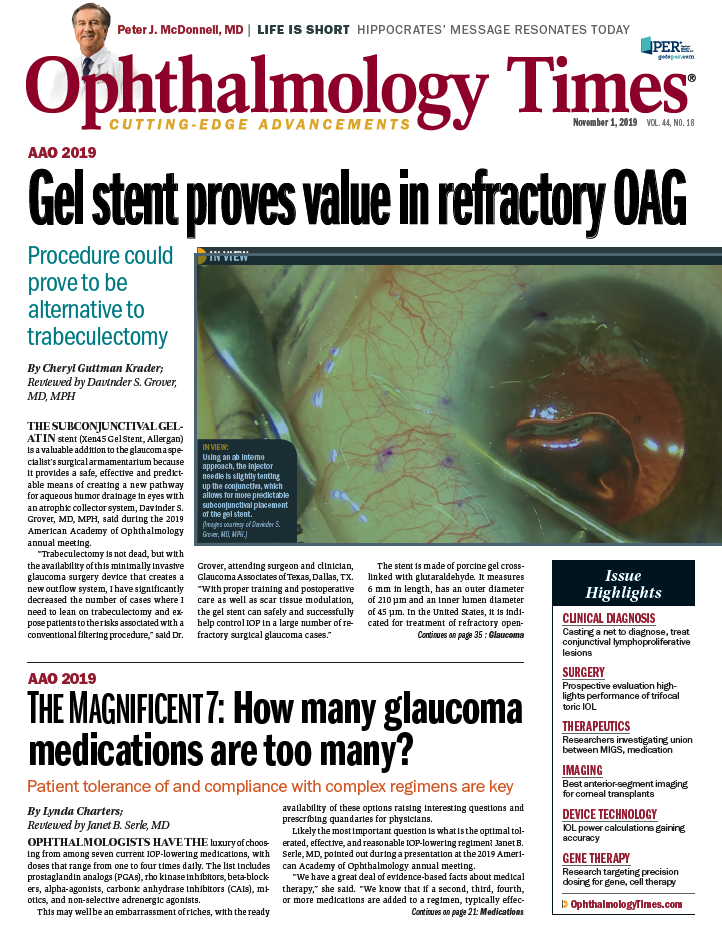Publication
Article
Digital Edition
Gel stent proves value in refractory OAG
Author(s):

Procedure could prove to be alternative to trabeculectomy.
This article was reviewed by Davinder S. Grover, MD, MPH
The subconjunctival gelatin stent (Xen45 Gel Stent, Allergan) is a valuable addition to the glaucoma specialist’s surgical armamentarium because it provides a safe, effective and predictable means of creating a new pathway for aqueous humor drainage in eyes with an atrophic collector system, Davinder S. Grover, MD, MPH, said during the 2019 American Academy of Ophthalmology annual meeting.
“Trabeculectomy is not dead, but with the availability of this minimally invasive glaucoma surgery device that creates a new outflow system, I have significantly decreased the number of cases where I need to lean on trabeculectomy and expose patients to the risks associated with a conventional filtering procedure,” said Dr. Grover, attending surgeon and clinician, Glaucoma Associates of Texas, Dallas, TX. “With proper training and postoperative care as well as scar tissue modulation, the gel stent can safely and successfully help control IOP in a large number of refractory surgical glaucoma cases.”
Related: Controlling adult glaucoma with cataract surgery, stent
The stent is made of porcine gel crosslinked with glutaraldehyde. It measures 6 mm in length, has an outer diameter of 210 µm and an inner lumen diameter of 45 µm. In the United States, it is indicated for treatment of refractory open-angle glaucoma.
The stent can be used regardless of glaucoma stage, and does not have to be combined with cataract surgery.
Traditionally, the stent has been placed in an ab interno procedure with delivery through a 1.8 mm clear corneal incision, but an ab externo approach performed through the conjunctiva or a small peritomy is possible, and the technique appears to be moving in that direction, Dr. Grover said.
Presenting an intraoperative video, he provided this caution, “The surgery is not as easy as it looks, but with experience and proper training, it can be done well and provide a very safe and effective surgical treatment for glaucoma.”
“One of the greatest technical challenges is becoming familiar with the ergonomics of the slider and injector used for the procedure.”
Related: Pearls to manage cataract surgery on hyptonous eyes
Describing his personal ab interno approach, Dr. Grover said the implantation is done under topical anesthesia.
He creates a 1 mm paracentesis in the superior temporal cornea, roughly 90° away from the planned main corneal incision through which he injects a high molecular weight cohesive viscoelastic (Healon GV, Johnson & Johnson Vision).
Then he makes the clear corneal incision, and after rotating the globe inferiorly and drying the superior conjunctiva, places a mark 2 mm posterior to the limbus, as a guide to proper subconjunctival and intrascleral positioning of the stent.

Related: iStent implantation with cataract surgery
“The device is 6 mm long, and in my experience, it ideally should lie 1 mm in the anterior chamber, 2 mm in the scleral wall, and 3 mm in the subconjunctival space,” he explained. Passing the needle tip of the injector system through the corneal wound can be a little difficult but a slight “shimmy” is helpful.
Positioning and seating the needle in the superior angle is done under gonioscopic guidance. Dr. Grover noted that placing viscoelastic on the gonioprism is useful for maintaining good visibility.
According to Dr. Grover, his goal is to seat the needle tip of the injector just slightly anterior to the trabecular meshwork. A key maneuver involves stabilizing the injector while delivering the stent to avoid a flick as the needle from the injector disengages from the scleral wall and retracts into the injector.
“This was an initial hurdle for me,” he said.
Once the injector has been fully inserted and the needle tip is tenting up the conjunctiva, Dr. Grover slowly advances the blue slider halfway to insert the gel stent in the subconjunctival space.
“I want to exit right where the 2 mm mark is, and I want to be certain that it is in the subconjunctival space,” he said. “Perforation is possible, but it would be hard to do and is extremely rare.”
Related: Refractive considerations in cataract surgery in glaucoma patients
If perforation occurs, the surgeon should simply bring the injector back into the anterior chamber, move the needle tip 1 to 2 clock hours to either side, and re-implant.
“The small conjunctival perforation is usually small and does not leak, but make sure it is Seidel negative at the end of the case,” Dr. Grover said.
After implantation, inspection with gonioscopy should confirm that the implant is positioned away from the iris with proper proportions in the anterior chamber and subconjunctival space.
“Using a blunt instrument or the back side of a cannula, the surgeon can roll away the chemosis, starting from the limbus towards to fornix, to flatten the conjunctiva and visualize the implant in the subconjunctival space,” Dr. Grover said. “You want to see that the stent is mobile and able to flap freely to the left and right, which is a sign that it is free of any obstruction and not imbedded in Tenon’s capsule.”
Related: Surgeons share their experience of a new approach to gel stent implantation
Undiluted mitomycin-C (40 to 80 μg) is then injected subconjunctivally in the target quadrant away from the limbus, but first Dr. Grover said he injects a small bolus of 2% lidocaine to improve patient comfort.
“Because the procedure is done under topical anesthesia, patients will feel the burn of the mitomycin-C,” he explained. “A small lidocaine bolus has made a big difference for my patients and for me.”
A low bleb forms with the gelatin stent. Dr. Grover said that postoperative needling with mitomycin-C is needed in about 20% to 30% of cases.
“Knowing how to needle and manipulate the bleb postoperatively is an essential component to success,” he said. “If the idea of a bleb or the need for postoperative manipulation scares you, my advice would be to ask yourself if this is a procedure that you want to learn.”
Related: Bag-in-the-lens IOL reduces postop issues tied to previous models
Outcomes
Data from the 510(k) pivotal trial that included 65 eyes of 65 patients showed that at 12 months, 75.4% of eyes had achieved IOP lowering from baseline of at least 20% while being on the same number or fewer medications.
Mean baseline IOP was 25 mm Hg and it was reduced by an average of 9.1 mm Hg in the 52 patients who completed the 12-month followup. Mean number of medications was reduced by 50% from 3.5 to 1.7. There were no significant or unexpected complications.
Dr. Grover was lead author of the published article reporting the 12-month outcomes [Grover DS, et al. Am J Ophthalmol. 2017;183:25-36].
“In general, success rates over time in glaucoma surgery are in the 70-80% range, and so this is a very good result considering that the eyes in the study were very refractory cases with advanced disease,” he said.

Related: Innovations focusing on improved patient experience
Patient selection
Dr. Grover said he uses the gel stent when angle surgery cannot be used, has failed, or is not expected to be effective. It can be effective if follow-up is difficult, for example because the patient has a long commute, is expected to be non-compliant, or needs to get back to work quickly; if a patient is on a blood thinner that cannot be discontinued for a few weeks; and when it is important to have a predictable refractive outcome.
Dr. Grover added that he will not use it if there is active inflammation; extensive superior peripheral anterior synechiae; angle closure (unless the procedure is combined with phacoemulsification), neovascular glaucoma; an anterior chamber, unstable posterior chamber, or sutured IOL; or if the patient has iridocorneal endothelial syndrome or is expected to need penetrating keratoplasty.
Dr. Grover provided a caution to consider facial anatomy because the presence of a prominent cheekbone and sunken eye may make surgery more challenging.
“In this situation, try to go as far nasal as possible,” he concluded.
Read more glaucoma content here
Davinder S. Grover, MD, MPHE: dgrover@glaucomaassociates.com
This article is based on Dr. Grover's presentation at the American Academy of Ophthalmology 2019 annual meeting. Dr. Grover is a consultant to and investigator for Allergan.
Newsletter
Don’t miss out—get Ophthalmology Times updates on the latest clinical advancements and expert interviews, straight to your inbox.





